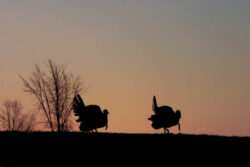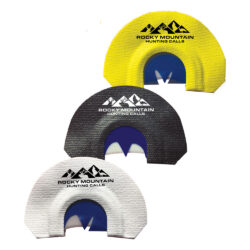Spring turkey season is simply amazing. Hunting is so different when you can call and talk to the animals. I have always compared Turkey season to September archery elk hunting. The main difference is about 800 lbs., but the tactics and strategy are so similar. You can even use an elk diaphragm call to make turkey sounds.
For many Spring Gobbler chasers, the first moments of sunrise are the best. Having a gobbler fly into your predawn decoy set up is exciting but a rare event. When the whippoorwills begin to call, so do the hens and gobblers. Morning gobbles will be abundant as they begin to single out hens to mate with.
Many experienced Turkey hunters would give up the entire sunrise calling session for one gobbler talking after 10AM. Since you can only tag one bird, you only need one responsive bird to call in.
Sunrise Gobblers roost near other hens. They already have full dance cards. Some early morning Jakes may fly by but the wise, mature, longbeards are busy until later in the day.
Once the hens have all been serviced, they march off to their nests. The Gobblers may continue to look for some hen love. This is when an experienced turkey hunter strikes. Soft, sexy hen purrs, and kee kee runs will do the trick. Don’t challenge the gobbler with gobble calls. They are too exhausted to fight with another male. One more hen is often a good way to hook up.
Getting up early is my least favorite thing to do. Once I am up and moving around, I am glad to get up but the first 10 minutes is tough. With some coffee and motivation, I am ready to go.
Most of my Spring turkey shots have happened after 10AM. Back in Maryland, you could only hunt until 12 noon. There were many days when I was near to closing the deal on a gobbler and ran out of time.
Montana allows an all-day hunt. Even with this extra time, 90% of my filled turkey tags happen between 10-12PM. It usually starts with a distant cluck or gobble, that responds to my loud kee kee run. That’s when I close the distance. My goal is to get within 100 yards before I call again. This is often tough when you get a Walkabout Gobbler. Some birds just seem to be taking a long hike, with an occasional gobble. For these birds, I try to angle my path so I can get in front of them.
My next calls are soft, sexy, and tell a story. Calling needs to say something like, “hey big boy, I am waiting over you over here, and I am so…” You get the message.
Some afternoon hunters have success in the evening, when they “put the birds to bed”. I routinely try and do this but rarely get a shot.
Take the time to scout and be ready when the gobbler is.
Montana Grant